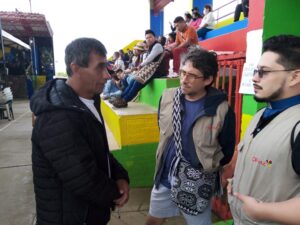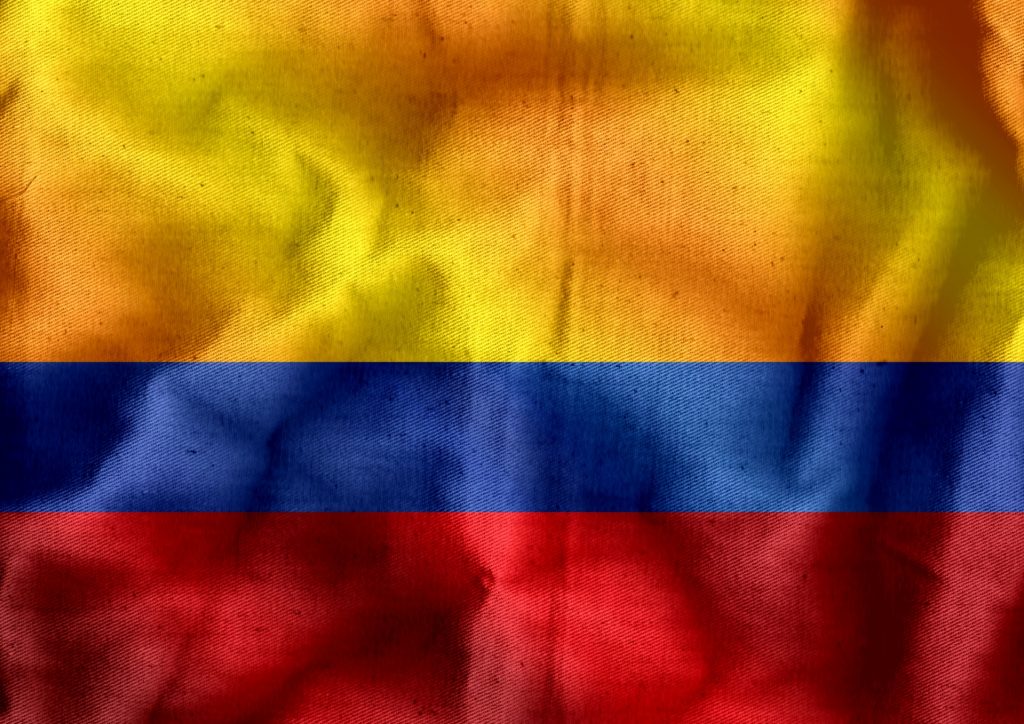Five Years After Disarmament in Colombia: A Community Still Insists on Seeking Peace
Alvin Góngora, Latin America and Caribbean News Agency (ALC)
(Note from the Editor: This article narrates one of the visits of the International Pilgrimage of Solidarity with Colombia, sponsored by the World Council of Churches, the World Communion of Reformed Churches, Global Ministries, and other sister organizations, with the Interchurch Dialogue for Peace, DiPaz, from Colombia. The visit was held on November 26-30, 2021. Alex Maldonado Lizardi and Xiomara Cintrón García, our Mission Co-workers assigned to serve with Justapaz, were part of the delegation)

On November 24, 2016, the Colombian government and the FARC signed an agreement for the disarmament of the guerrillas and the beginning of a peace process, based on six fundamental commitments. After five years, the balance is grim. Although there are encouraging features (laying down of arms, incorporation of the vast majority of combatants into civil life, political participation of the former guerrillas, implementation of a special jurisdiction to hear crimes committed in the framework of the armed conflict), the fulfillment of the Peace Accords, in general, is still a considerable distance from what was proposed and signed in the final document.
Perhaps because peace in Colombia travels a path riddled with antipersonnel mines and because missteps outnumber advances, the five-year celebration of the Havana Accords resonates more deeply deep within the social dynamics of communities affected directly by the conflict.
One of these sectors is the one made up of the bulk of indigenous peoples in their diversity. The Nasa people stand out from this universe. Settled in the southwest of Colombia, mainly in the department of Cauca, they have a long history of resistance to threats of extinction and the realities of persecution, violence, and assimilation. However, at the same time, Nasa has managed to recover many levels of organization. That has allowed them to preserve their ancestral memories, appropriate their stories and knowledge, and win rights before the Colombian State (language, their own education, their own health, local government ).
In the context of the celebrations of the Havana Accords and during an international pastoral visit of accompaniment and support sponsored by DiPaz (Interclesial Dialogue for Peace), we had the opportunity to visit the town of Caldono, 77 km south of Cali. This municipality is inhabited mainly by the Nasa nation that has witnessed harassment, violence, resistance, and social conquests. The territory of the municipality of Caldono, in the department of Cauca, is home to six indigenous reservations. Throughout the entire history of the armed conflict in Colombia, Caldono was always caught in the crossfire of insurgent forces of various stripes. It should be remembered that the FARC were not the only guerrillas that took up arms) and the national army. Some of its inhabitants joined the FARC guerrillas over time. Nilson Vargas, former combatant and actual president of an agricultural cooperative that brings together 485 families of former FARC guerrillas, recalls that out of 510 combatants who concentrated in the area to start the process of laying down their arms, 87% were indigenous.
The natural environment of the Caldono territory shows the fruits of peace. Once you take the central highway from Cali into the country’s south, climbing into the Andes to go after the hollows of the mountain range surrounding that municipality, you get immersed in a landscape dotted with small green parcels. The crops of coffee, banana, fruit trees seem to tell stories of the intense work of entire communities as if they could finally breathe again. Faithful to their hard-worked identities that link human communities to the territory, those of Caldono underline the centrality of the community in a distribution of land that abhors the latifundio (Large agricultural estate owned by a single owner). Small productive family units follow one another along the road to the end, almost abruptly, in the urban area dominated by the cathedral.
The solidarity visit organized by DiPaz coincided with the day on which the “Juntos por Caldono” Association held an intercultural arts festival. The festival was also used to evaluate these five years of search for reconciliation and peace. While conservative sectors at the highest echelons of the country’s political spectrum continuously attack the process of seeking a stable peace, there is no doubt that, at the grassroots level, the spirit of celebration cannot be hidden.
Conversations with former combatants, local authorities, indigenous spokespersons, pastoral agents, clergymen, local artists, and outside facilitators attest to a robust grassroots commitment to peace. They have the same faithfulness now as five years ago when they endorsed the Accords. Thus, for example, the parish priest of Caldono, Father Javier, insists that the challenges they now face have to do with building a post-conflict society. Putting his own life at risk, this cleric urges the general mobilization against the new threats of drug trafficking and social cleansing backed by organized crime and drug cartels. They are long-standing problems and complications that currently fill the void left by armed insurgent groups.
Father Javier highlighted the importance of prayer as a central feature of the ecumenical mobilization of the churches in favor of peace in the territory. When one listens to spokesmen for the population, it is verified that, in effect, faith is a constitutive part of the social imaginary. Thus, for example, Fredy Julicué, a spokesman for the council, without further ado, began his speech at the intercultural festival of the day with the following words: “I want to thank the first ones who came to support us in peace: DiPaz, Mencoldes, to the Christian Alliance Church…” Later he continued recounting what has been 20 years of resistance, which is a period that coincides with the seizure of public power by the extreme right. In a personal conversation, Julicué specified: “It was DiPaz who taught us how to make peace.”
For Devia, a former FARC combatant, trust is a profoundly human component that lies at the core of faith. He affirmed that as expressed in religious traditions in general and the outstanding contribution of the ecumenical movement to the communities in Caldono. With him, “Juanito,” another former FARC combatant, agreed. “Juanito,” said that, after 27 years in the insurgency, he discovered that trust is the antidote to the fear under which he still lives. These resources have been treasuring in the brief stretch of peace so far traveled. That allows former guerrilla combatants like Nilson, “Juanito,” Devia, members of the community that support them like Julicué, and clergy like Father Javier to push the agenda for forgiveness and reconciliation towards the horizon of reintegration that transcends individual experiences. It is about territorial and social reintegration.
“I laid down my arms and found myself with my tongue, my language,” Nilson concludes. When he was very young, he joined the ranks of the FARC. He was stripped of his mother tongue. Now that his capacity to fight is reoriented towards strengthening the agricultural cooperative that brings together 485 associates, all of them reinserted fighters, the search for peace is expressed as a search for ũuste wẽt ũswa’ja ‘, “peace” in Nasa Yuwe. This is the language in which he began to capture the world, which today contributes to the new realities of post-conflict. These realities include complexities such as those posed to him and his colleagues. They confront obstacles to marketing their agricultural products, efforts to search for former colleagues from whom there is no news, and initiatives to strengthen the Peace Accords’implementation.
However, the communities are not deceived. Building trust remains a challenge, despite the ground gained thus far. The past continues to weigh on the daily lives of former combatants. It continues to affect their relations with the communities. Immediate difficulties like generating income for the reintegrated and their families’ support are increasingly determining whether to continue betting for peace or, on the contrary, to opt for more complex, alternative routes. The boom in drug trafficking appears to be closing in on Caldono. Organized crime acts as if it enjoys complete legitimacy.
Added to this is the negative stance of the high government. It has never looked favorably on the disarmament agreement with the FARC. Although President Iván Duque communicates to the international community a commitment to peace, his actions and decisions contradict his speech. Duties included in the Peace Accords, such as reintegrating ex-combatants and creating a comprehensive rural policy, are being annihilated by attrition. The smear campaigns from the media promoted by the actual government through its officials’ public statements undermine the legitimacy of the Court in charge of the Special Jurisdiction for Peace. The rarefied atmosphere increased even more during the recent National Strike. The public authorities, ignoring the legitimacy of a peaceful protest, transferred military strategies and war actions to urban centers. That devastated peasants, indigenous peoples, and Afro-descendant communities in the rural sectors.
Still, Caldono donned his party outfit. His commitment to peace is unwavering.
See original article, in Spanish: https://alc-noticias.net/es/2021/12/01/a-cinco-anos-de-un-desarme-en-colombia-una-comunidad-que-insiste-en-buscar-la-paz/
WORDS BY GLOBAL MINISTRIES’MISSION CO-WORKER, ALEX MALDONADO LIZARDI, AS PART OF THE DELEGATION THAT VISITED CALDONO
“Despite governmental efforts to ignore the 2016 peace agreement, different communities in the most remote territories of Colombia reinforce their commitments to it. They celebrate their achievements and results in profound and challenging works of reconciliation and reintegration into life as they reflect on the redemptive possibilities of political forgiveness. The wounds are many, but the zeal of these communities for comprehensive peace with justice is more than extraordinary.”
The Mennonite Center for Justice, Peace, and Nonviolent Action (Justapaz) and the Evangelical Council of Colombia’s Peace and Justice Commission continue their work for peace and justice in Colombia, by advocating for the compliance of the 2016 Peace Accords. They also document violations of Human Rights, accompany displaced families because of violence, and assist women and children, and develop sustainable initiatives for the wellbeing of communities in the country. To support our partners in Colombia, you can contribute financially through Global Ministries. Information on sending gifts to Global Ministries online, by check in the mail, or by phone can be found at www.globalministries.org/give.

